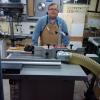I’m looking for some advice on a planer/jointer solution for my woodworking. I would like to build my son a loft bed and I’ve purchased some plans for making one. It’s almost entirely 2x4 and 2x6 pine construction and a pretty simple build. I’m primarily a woodturner so most of my shop revolves around that and I own only a lathe, bandsaw, chop saw, circular saw, (no table saw.) I know I won’t be happy with the final product if I use lumber from the big box store and don’t mill it to some extent as I would like to bed to look as “furniture grade” as I can. What solution would you recommend to plane/joint the dimensional lumber so all my lap joints look good and the final product looks professional? I’m considering picking up an electric hand planer to true up the store bought lumber. Will this be sufficient or do I need to invest in something larger and more substantial?






 Reply With Quote
Reply With Quote







